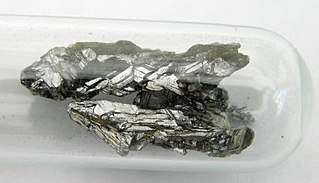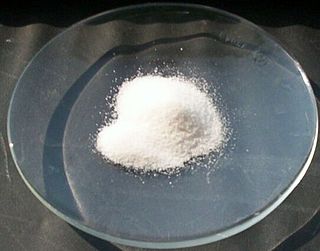Arsenic oxide may refer to any of the following:
- Arsenic dioxide, As2O4
- Arsenic trioxide, As2O3
- Arsenic pentoxide, As2O5
Arsenic oxide may refer to any of the following:

Arsenic is a chemical element with the symbol As and the atomic number 33. It is a metalloid and one of the pnictogens, and therefore shares many properties with its group 15 neighbors phosphorus and antimony. Arsenic is a notoriously toxic heavy metal. It occurs naturally in many minerals, usually in combination with sulfur and metals, but also as a pure elemental crystal. It has various allotropes, but only the grey form, which has a metallic appearance, is important to industry.
Ass most commonly refers to:

Arsenic poisoning is a medical condition that occurs due to elevated levels of arsenic in the body. If arsenic poisoning occurs over a brief period of time, symptoms may include vomiting, abdominal pain, encephalopathy, and watery diarrhea that contains blood. Long-term exposure can result in thickening of the skin, darker skin, abdominal pain, diarrhea, heart disease, numbness, and cancer.

Phar Lap was a New Zealand-born champion Australian Thoroughbred racehorse. Achieving incredible success during his distinguished career, his initial underdog status gave people hope during the early years of the Great Depression. He won the Melbourne Cup, two Cox Plates, the Australian Derby, and 19 other weight-for-age races.
Asp may refer to:
Hijiki, sometimes called hiziki, is a brown sea vegetable that grows wild on the rocky coastlines of East Asia.

Mineral springs are naturally occurring springs that produce hard water, water that contains dissolved minerals. Salts, sulfur compounds, and gases are among the substances that can be dissolved in the spring water during its passage underground. In this they are unlike sweet springs, which produce soft water with no noticeable dissolved gasses. The dissolved minerals may alter the water's taste. Mineral water obtained from mineral springs, and the precipitated salts such as Epsom salt have long been important commercial products.
Arsenic and Old Lace may refer to:

Arsenic trioxide is an inorganic compound with the formula As
2O
3. As an industrial chemical, its major uses include the manufacture of wood preservatives, pesticides, and glass. It is sold under the brand name Trisenox among others when used as a medication to treat a type of cancer known as acute promyelocytic leukemia. For this use it is given by injection into a vein.

Scheele's Green, also called Schloss Green, is chemically a cupric hydrogen arsenite, CuHAsO
3. It is chemically related to Paris Green. Scheele's Green was invented in 1775 by Carl Wilhelm Scheele. By the end of the 19th century, it had virtually replaced the older green pigments based on copper carbonate. It is a yellowish-green pigment commonly used during the early to mid-19th century in paints as well as being directly incorporated into a variety of products as a colorant. It began to fall out of favor after the 1860s because of its toxicity and the instability of its color in the presence of sulfides and various chemical pollutants. The acutely toxic nature of Scheele's green as well as other arsenic-containing green pigments such as Paris Green may have contributed to the sharp decline in the popularity of the color green in late Victorian society. By the dawn of the 20th century, Scheele's green had completely fallen out of use as a pigment but was still in use as an insecticide into the 1930s. At least two modern reproductions of Scheele's green hue with modern non-toxic pigments have been made, with similar but non-identical color coordinates: one with hex#3c7a18 and another with hex#478800. The latter is the more typically reported color coordinate for Scheele's green.
Arsenic sulfide may refer to:
33 may refer to:
Asshole or arsehole is a vulgar term for the anus, or an insult derived from this meaning.
Old Lace may refer to:
Arsenic chloride may refer to either of the following:
Arsenic fluoride may refer to either of the following:
Tribromide is the anion with the chemical formula Br3−, or salts containing it:

GFAJ-1 is a strain of rod-shaped bacteria in the family Halomonadaceae. It is an extremophile that was isolated from the hypersaline and alkaline Mono Lake in eastern California by geobiologist Felisa Wolfe-Simon, a NASA research fellow in residence at the US Geological Survey. In a 2010 Science journal publication, the authors claimed that the microbe, when starved of phosphorus, is capable of substituting arsenic for a small percentage of its phosphorus to sustain its growth. Immediately after publication, other microbiologists and biochemists expressed doubt about this claim, which was robustly criticized in the scientific community. Subsequent independent studies published in 2012 found no detectable arsenate in the DNA of GFAJ-1, refuted the claim, and demonstrated that GFAJ-1 is simply an arsenate-resistant, phosphate-dependent organism.
Johann Schröder may refer to:
Arsenic is the chemical element with symbol As and atomic number 33.